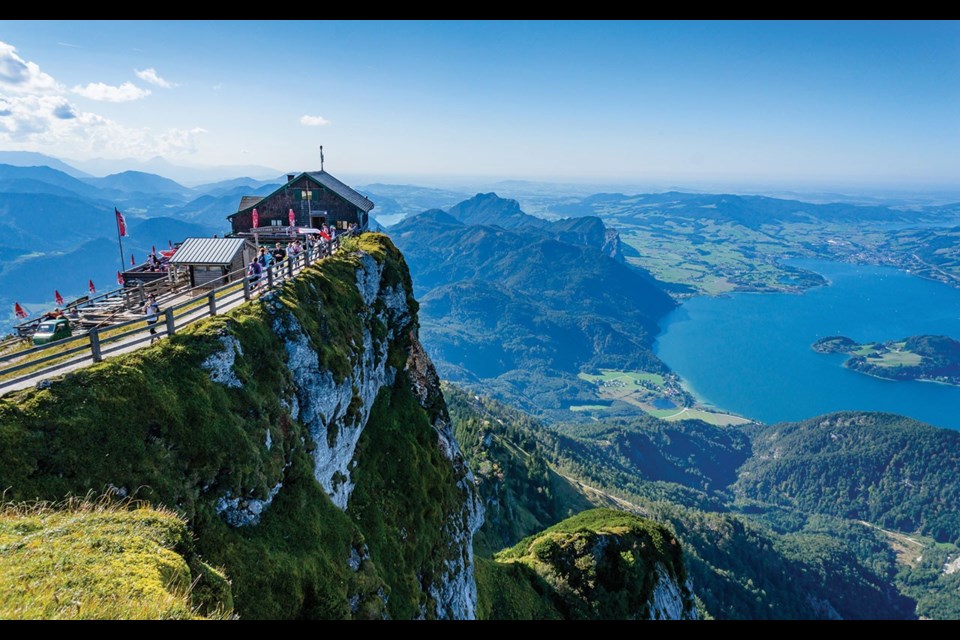The little nostalgic steam engine huffs and puffs its way up the steep track as we leave the lakeside village of St. Wolfgang in Austria. We are bound for Schafberg Mountain and our carriage is full of expectant and excited people. The joy of travelling in toy mountain trains is unexplainable in words but we all feel it. This is a real adventure.
The steepest, steam cog-railway in Austria has been ascending this mountain since 1893. It takes 35 minutes to reach the summit, climbing 1,190 metres over 5.85 kilometres. Along the way we pass through forest, rocky terrain and rolling grassland. The views are magical but many of the passengers are concentrating on the little locomotive as it struggles up the track with the help of its cog drive.
The two original cog railway's steam engines count amongst the oldest working engines in the world as they were built in 1893 and 1892. In 1992, four modern locomotives were built that operate their steam engines with diesel. Older diesel engine locomotives from the 1960s are kept and maintained for emergencies and there are two modern diesel locomotives.
The Schafbergbahn featured in the Sound of Music movie and it is a highly popular day-trip destination among both locals and tourists. The view from the summit (1,783 m) is the most spectacular in this world-famous region. On a clear day, there is a 360-degree panoramic view over the glittering lakes and across the mountains into Germany. All around, the mountains soar majestically, and you have this feeling of being on top of the world.
The terminal at the top of the mountain is close to a hotel and several restaurants and it is surrounded by rocky walking paths that test your fitness. Train tickets to the top are purchased for a specific up-hill train, and we learnt there is heavy demand for mid-morning departures. For the best views, sit on the left-hand side of the train on the way up and the right-hand side on the way down. You need to book your return journey once you reach the top.
The construction of the Schafbergbahn dates back to the late 19th century. At that time, Viennese aristocrats wanted to spend the summer in the mountains. The railway network had been rapidly developed and an early form of tourism to accommodate the visitors became an important source of income for many locals.
A consortium of investors funded the construction of the mountain railway in 1893. Financial difficulties forced the owners to sell in 1932 then in 1938, it became the property of Nazi-Germany's Reichsbahn and later of the Austrian National Railway ÖBB. Finally, the Schafbergbahn was sold again in 2006. Since then, it has been owned by the Salzburg AG company and it is operated in association with the boats that cruise Lake Wolfgangsee.
The way down is no less exciting as the engine struggles to control the rate of descent on the steep track. At one point, we stop to allow another train to pass and see the train guard feverishly operating the points before we proceed. Finally, it is back to level ground and on to our next adventure.
Hallstatt is some 35 kms away. Some regard this as the most beautiful village in the world. The Chinese were so impressed that they produced a replica of it in Guangdong but thousands still flock here to see the original. It is difficult not to be impressed by the real UNESCO-listed version.
From the market square which hosts summer concerts and the Christmas Market, you are just a short walk away from one of the most beautiful photo points in Europe. But it is also the romantic alleyways, cosy cafés, delightful churches and the numerous little souvenir shops that make this place so appealing.
The charnel house or "Bone House" in St. Michael's Chapel with its unusual collection of over 600 artistically painted skulls is one of the more interesting tourist sites. Because of restricted land area, when an existing grave was reused for a new burial, the old skull or bones were transferred from the grave to the charnel house as part of a second funeral.
The World Heritage Museum is another attraction. Multimedia technology takes you back 7,000 years to the beginnings of this ancient salt mining town. With 3D glasses, you can immerse yourself in the history of old Hallstatt and learn trivia from the beginning of human presence to the elevation of the region to its World Heritage status.
People have been mining salt above Hallstatt for thousands of years and a visit to the mine can be a great experience. You reach it by funicular then enjoy a miner's slide, a subterranean salt lake and an exciting trip on the mining railway. While here, take a small detour to the Hallstatt Sky Walk. This spectacular viewing platform sits high above the village and offers an idyllic panoramic view of Lake Hallstatt and breathtaking alpine landscape.
Electric boat driving is one of the most popular pastimes on Lake Hallstatt. The fresh air and the beautiful nature of the fjord-like lake combine to provide a relaxing experience. You can either captain the boat yourself or take an experienced driver who will take you to the most beautiful parts of the lake.
Available space is in short supply making parking in the village a problem, so the village centre is traffic-free during the daytime and visitors must park in several car parks nearby. These are within walking distance of all attractions but space is limited and we see late-comers having to queue for spaces as others leave. If you plan to visit, arrive before 9 a.m. if possible.
If You Go: There are one-stop flights from Vancouver to Vienna, the capital of Austria, by several airlines. Hallstatt and the Schafbergbahn are about 300 kms west and are reachable by rental car or train.




